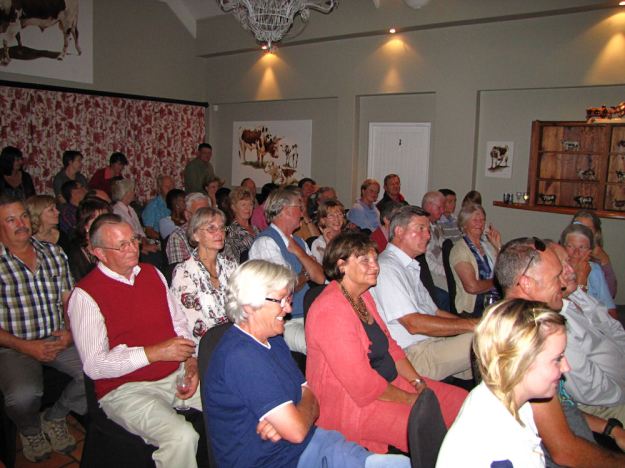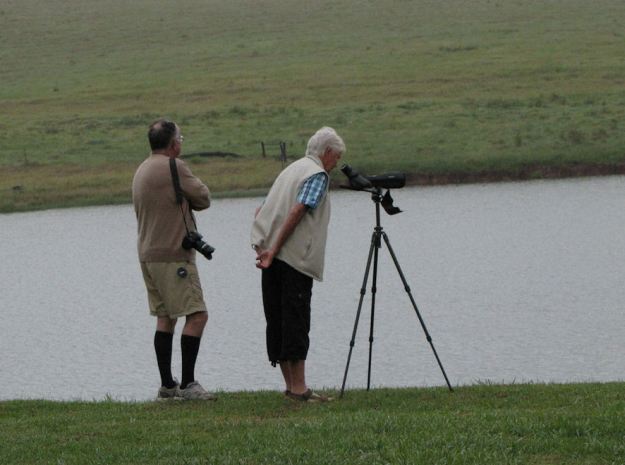Since George Archibald could crawl, he has been following birds. Growing up in Nova Scotia, Canada, his parents kept chickens which he adored. As soon as he could explore a little further, he spent time in the wilds surrounding their homestead with moose, bears and deer. He recalls eagles nesting along the river and lots of warblers. “There was a small island just off the coast and I’d get the fishermen to take me out and leave me there all day discovering interesting bird’s nests. I’d take some of the eggs to put under our chickens at home, to watch them hatch and then return the birds to the wild!”
Dr George Archibald is now the world’s leading expert on Cranes and recently visited the Midlands to stay with his friend and colleague Ann Burke, Conservation Programme Manager of the KZN Crane Foundation (KZNCF). He spent a couple of days visiting sites with significant populations of cranes with Tanya Smith Endangered Wildlife Trust (EWT) and also met with others concerned with Crane Conservation in KZN.
In his presentations to the public, both at a function hosted by the Karkloof Conservancy and another for supporters and friends of the KZN Crane Foundation, he talked about his life’s work and especially about the successes of Crane Champions in Africa – in particular mentioning Samson Phakathi as one of his heroes.
In welcoming him, Ann Burke read: “It brings me great joy to introduce Dr George Archibald, award-winning pioneer, conservation icon and co-founder of the International Crane Foundation. Dr Archibald has cultivated and revolutionized the preservation of rare crane species and their wetland and grassland habitats. In 1973 he co-founded the International Crane Foundation, in Baraboo, Wisconsin. The foundation emerged at a perilous time for cranes, when many of the 15 remaining species were experiencing significant declines in their populations. George and Ron Sauey, a colleague from Cornell University, started the foundation on a horse farm owned by Ron’s parents. When they began, little was known about the breeding biology of cranes, with some species never having been hatched or bred in captivity. Ron and George worked to create a “species bank” for cranes, reasoning that breeding cranes in captivity was one important step toward safeguarding them in the wild. Through the International Crane Foundation, George’s efforts have led to the conservation of more than 5 million hectares of wetlands in Asia, and he has organized more than 900 researchers working with cranes in more than 60 nations.”
 Dr Archibald told us that in 1940, only 15 North American Whooping Cranes remained and how through the efforts of the Canadian and US governments and the International Crane Foundation, they now number 250. He pointed out the parallel with our own Wattled Cranes – only 260 left in the wild – and spoke about the importance of sustained support for the Wattled Crane Nursery being built at the KZNCF headquarters in Nottingham Road and of course, the important support necessary for a release programme. Dr Archibald helped establish several techniques to rear cranes in human care, such as having human handlers wear crane costumes to avoid human imprinting and using ultra-light aircraft to lead cranes on migration.
Dr Archibald told us that in 1940, only 15 North American Whooping Cranes remained and how through the efforts of the Canadian and US governments and the International Crane Foundation, they now number 250. He pointed out the parallel with our own Wattled Cranes – only 260 left in the wild – and spoke about the importance of sustained support for the Wattled Crane Nursery being built at the KZNCF headquarters in Nottingham Road and of course, the important support necessary for a release programme. Dr Archibald helped establish several techniques to rear cranes in human care, such as having human handlers wear crane costumes to avoid human imprinting and using ultra-light aircraft to lead cranes on migration. 
These techniques will be used by the KZNCF captive breeding programme to increase wild populations in South Africa. Lindiwe Mkhize, who dreams of being a ‘crane mama’ at KZNCF, was very taken with Dr Archibald. “It was an amazing experience to meet someone who has experienced the cranes hardships and suffering. I wish we could spend more time with him and pick his brain.”
Dr Archibald was delighted to meet local students and young environmental activists as he believes that education is imperative if conservation is to make real headway. He recalled “In 1954 I heard a radio programme which included a dramatization of how settlers had destroyed the habitat and had eaten many of the Whooping Cranes. I was enthralled. It galvanised my commitment to work with Cranes.” He feels that a properly delivered message goes straight to the heart of children and great storytelling is a key tool. Grade 12 student Nkulu Mdladla commented: “His presentation and pictures were really good and told his story well. I felt as if I was travelling with him. I really liked the idea he gave us about a Crane Festival. That is a good plan for children, so they will take care of the cranes.”
Dr Archibald sites Aldo Leopold as a major inspiration and quoted him often during his presentation. “Amid the endless mediocrity of the commonplace, a crane marsh holds a paleontological patent of nobility, won in the march of aeons, and revocable only by shot gun. The sadness discernible in some marsh arises, perhaps, from their once having harbored cranes. Now they stand humbled, adrift in history.” Leopald felt that the time had come to extend ethical criteria to include the broader biotic community. Leopold’s conviction was that humans would hopefully reconsider themselves and the biotic community in a different way when confronted with the realities of natural history.
Today Dr Archibald is known globally as the world’s leading scientific authority on cranes, and he has received numerous awards and honours worldwide. He has received 4 honorary doctoral degrees, the United Nations has placed him on the Global 500 Roll of Honour for Environmental Achievement, he has received the Gold Medal from the World Wildlife Fund and most recently he was awarded the Dan W. Lufkin Prize for Environmental Leadership from The Audubon Society. Despite his incredible efforts, 11 of the world’s 15 Crane species are threatened.
Early on Saturday morning, two Southern African Grey Crowned Cranes swooped down to the dam at the KZNCF headquarters calling loudly and ensuring everyone dashed outside in their pyjamas to take a look. Despite having seen thousands in his life, George was as excited as everyone else, getting out his telescope so that we could take a good look at them sitting on the electricity pylons.
He was delighted by the interest shown by the students. Wendy Mkwanase commented. “I really enjoyed meeting him and hearing the story of his childhood. I wish I could visit him one day and talk to him more about animals and birds. I hope to meet again.”
Chris King added “I thoroughly enjoyed hearing about his background, how he was brought up and what inspired him. This illustrates the importance of us all making a commitment to encourage youngsters through good education programmes.”
Nic Shaw of Entabeni Environmental Education told the audience at Fordoun that 75 000 students had visited the Hlatikulu Crane and Wetland sanctuary over the years. The following morning, when Ann Burke, Lindiwe Mkhize and Bonisiwe Sibisi visited Bruntvillle for the inaugural KZNCF Enviro Club meeting, an overwhelming 120 children turned up to meet them! Obviously, there are plenty of enthusiast young people just waiting for a bit of Crane inspiration! This is great news for Crane . Thank you to Dr Archibald for his tireless efforts which have laid the foundation for our efforts in the Midlands.
Read about other Crane education initiatives: https://midlandsconservanciesforum.wordpress.com/2012/12/08/mountain-inspiration/
and https://midlandsconservanciesforum.wordpress.com/2012/06/24/learning-about-cranes/









It is thrilling to learn of the success of Dr Archibald’s visit; it will surely be a great encouragement to Crane enthusiasts; thank you for bringing the news of the enthusiastic responses to those of us who could not be there.personally
LikeLike
Thanks David – was really a lovely time with a lovely man. Sorry you didn’t make. xxx
LikeLike
A great evening; it is always inspiring listening to George.
LikeLike
Hi Nikki, well done for such a well written article. Gearge is one of those rare individuals who have given so much to conservation. In spite of his achievements he remains humble. I am very fortunate to have been his close friend for many years. Well done!!1
LikeLike
Pingback: Ann Burke – Crane Lady | Midlands Conservancies Forum